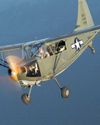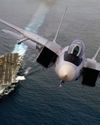試す 金 - 無料
Elliptical Elegance: Flying And Evaluating The Seafire Mark III
Flight Journal
|December 2019
It’s commonly agreed that the Spitfire/Seafire configuration was the most beautiful fighter ever. Its elliptical wing and long, slim fuselage were most delightful to the eye, and its flight characteristics equaled its aerodynamic excellence. The Navy Spitfire, the Seafire, was heavier, but otherwise retained all of the Spitfire’s delightful flight characteristics.

The Spitfire and Seafire series had only two unacceptable features to perturb a fighter pilot: one was caused by its configuration, and the other was the result of gross negligence on the part of the design team. The length of its nose and the aircraft’s steep, nose-high angle provided insufficient forward visibility when taxiing. The slimness of the fuselage alleviated this problem somewhat, but continual S-turns while taxiing were mandatory. And the cockpit’s internal layout was a disaster! It was configured as if blindfolded engineers had played “Pin the tail on the donkey.” Important switches, instruments and controls weren’t labeled and were small and hidden. Unimportant items, too, weren’t labeled, but they were large and always in the way. So much for the objective evaluation. In reality, combat pilots would forget these drawbacks when airborne!

I was checked out by two soon-to-be-famous Royal Navy lieutenants: Mike Lithgow, who became chief test pilot of the Supermarine after the War and also became my good friend; and Peter Twiss, who became chief test pilot at Fairey Aircraft. On March 10, 1956, he set a world speed record in the Fairey Delta-2 by flying the first jet aircraft to exceed 1,000mph in level flight. Lithgow and Twiss were not only friendly check pilots but were also most helpful in getting me off the ground and back to the flightline.

このストーリーは、Flight Journal の December 2019 版からのものです。
Magzter GOLD を購読すると、厳選された何千ものプレミアム記事や、10,000 以上の雑誌や新聞にアクセスできます。
すでに購読者ですか? サインイン
Flight Journal からのその他のストーリー

Flight Journal
ELLIPTICAL ELEGANCE
Flying and evaluating the Seafire Mark III
4 mins
November - December 2025

Flight Journal
IRON DOG
Fighting the Pacific and the P-39 at the same time
14 mins
November - December 2025

Flight Journal
Fighter Pilots: A Warrior Clan
TAKE A HARD LOOK at the two young men in these photos. Do they look as if they were bent on killing one another? On the left we have a young, unknown enlisted Japanese pilot standing in front of a Nakajima Ki-27 \"Nate,\" one of Japan's earliest monoplanes that led to the much vaunted Zero.
3 mins
November - December 2025

Flight Journal
KEN WALSH THE FIRST CORSAIR ACE
Medal of Honor pilot's combat adventures
12 mins
November - December 2025

Flight Journal
Big Chief's Little Chief
Thunderbolt action with the Wolf Pack
11 mins
November - December 2025

Flight Journal
ENEMY PILOTS SPEAK Voices from the other side
All too often American students of air warfare forget that enemy aircraftwhether Messerschmitts or MiGs-were flown by human beings with the same motivations and traits as Allied airmen. More often than not, the only difference between friend and foe was the paint on the airplane and where they landed. Therefore, we've assembled a variety of accounts from WW II Axis fighter pilots, men who were more than simply targets.
11 mins
November - December 2025

Flight Journal
FLYING THE FW 190
A legend gets checked out in the Butcher Bird
15 mins
November - December 2025

Flight Journal
DOUBLE-THEATER ACE
The fearless missions of legendary fighter pilot Col. John D. Landers
12 mins
November - December 2025

Flight Journal
WARBUG IN THE PACIFIC
Surviving combat in a Stinson OY-1/L-5
10 mins
September - October 2025

Flight Journal
WINGS OF THE FLEET
Celebrating the U.S. Navy's 250-year legacy
9 mins
September - October 2025
Translate
Change font size

